“Alice in Wonderland” — Meaning, Themes, and Symbols
Alice’s Adventures in Wonderland is a journey through a fantastical land, rich with symbolism and meaning.
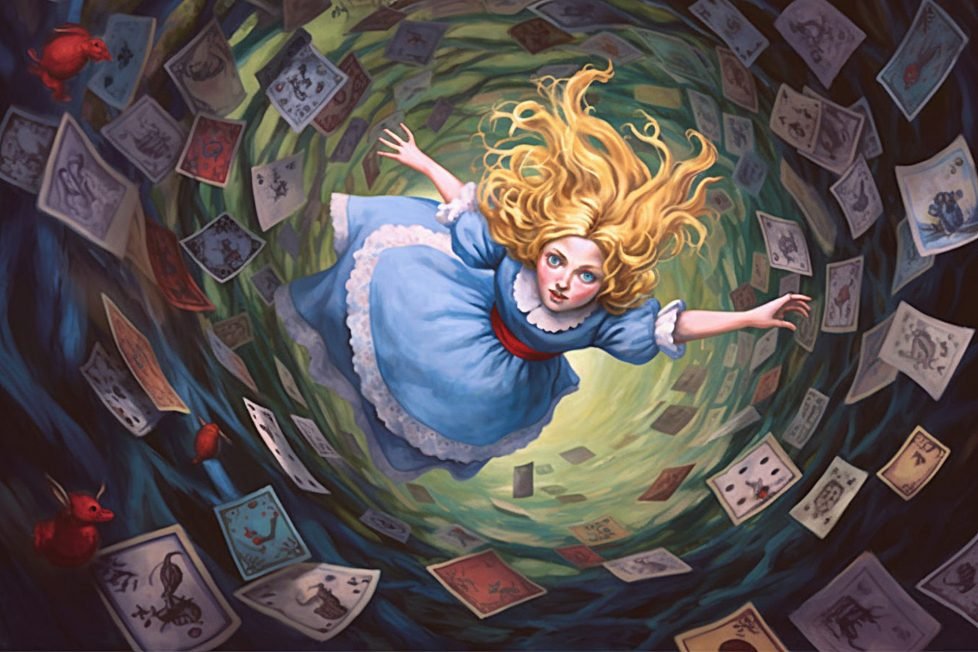
Alice’s Adventures in Wonderland is a journey through a fantastical land, rich with symbolism and meaning.

Table of Contents
ToggleLewis Carroll’s Alice’s Adventures in Wonderland has captured the hearts and imaginations of readers for generations, offering a lively, rich world of unforgettable characters, bent logic, and unexpected situations. In the Alice stories, Carroll created an alternate reality where ravens may be like writing desks and all roads lead to where you’re going.
However, underneath the whimsy of talking animals and magical tea parties lies deeper themes that have intrigued literary scholars and casual readers alike. These themes and ideas, ranging from drugs and mental health to transformation and growing up, connect the apparent silliness to the real world, giving Carroll’s stories a weight that has kept readers coming back for over 150 years.
Before we dive into the symbols and characters of Alice in Wonderland, let’s take a refresher on the actual story. Alice, a young girl, follows a white rabbit down a rabbit hole into a fantastical world where she encounters a host of peculiar characters and situations.
As she navigates this world, Alice meets a host of strange and eccentric characters, including the grinning Cheshire Cat, the tea-loving Mad Hatter, and the ruthless Queen of Hearts. She also discovers that things work very differently from what she is used to. For example, she grows and shrinks in size, plays a game of croquet with live flamingos, and attends a mad tea party that seems to go on forever.
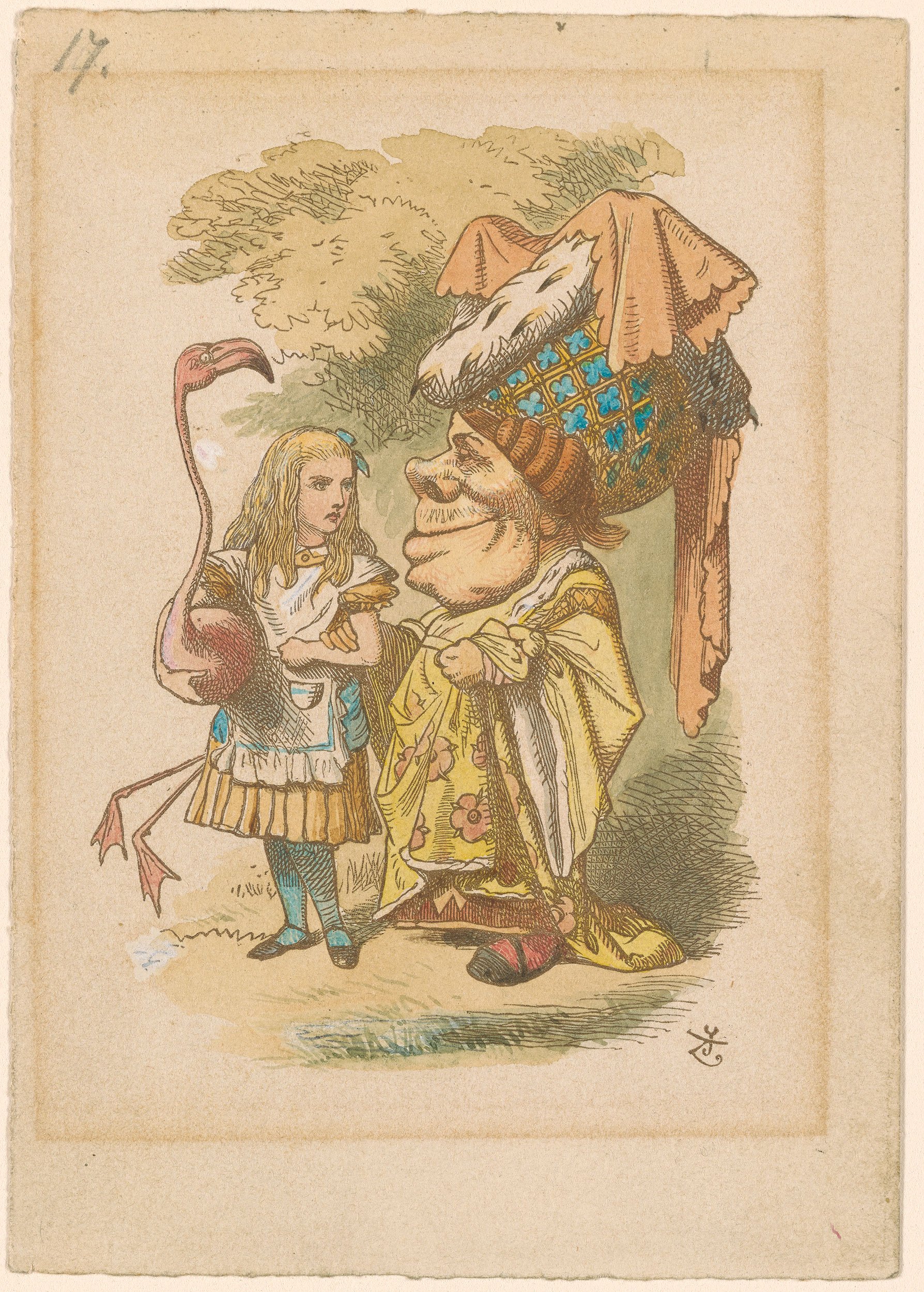
In the end, Alice wakes up from her dream and realizes that her adventures in Wonderland weren’t real. Although she’s initially disappointed, Alice comes to understand the importance of imagination and creativity in her life. She realizes that the lessons she learned in Wonderland can be carried with her, and that her experiences there have helped her grow and mature. The book ends on a hopeful note, suggesting that Alice’s adventures in Wonderland have left a lasting impression.
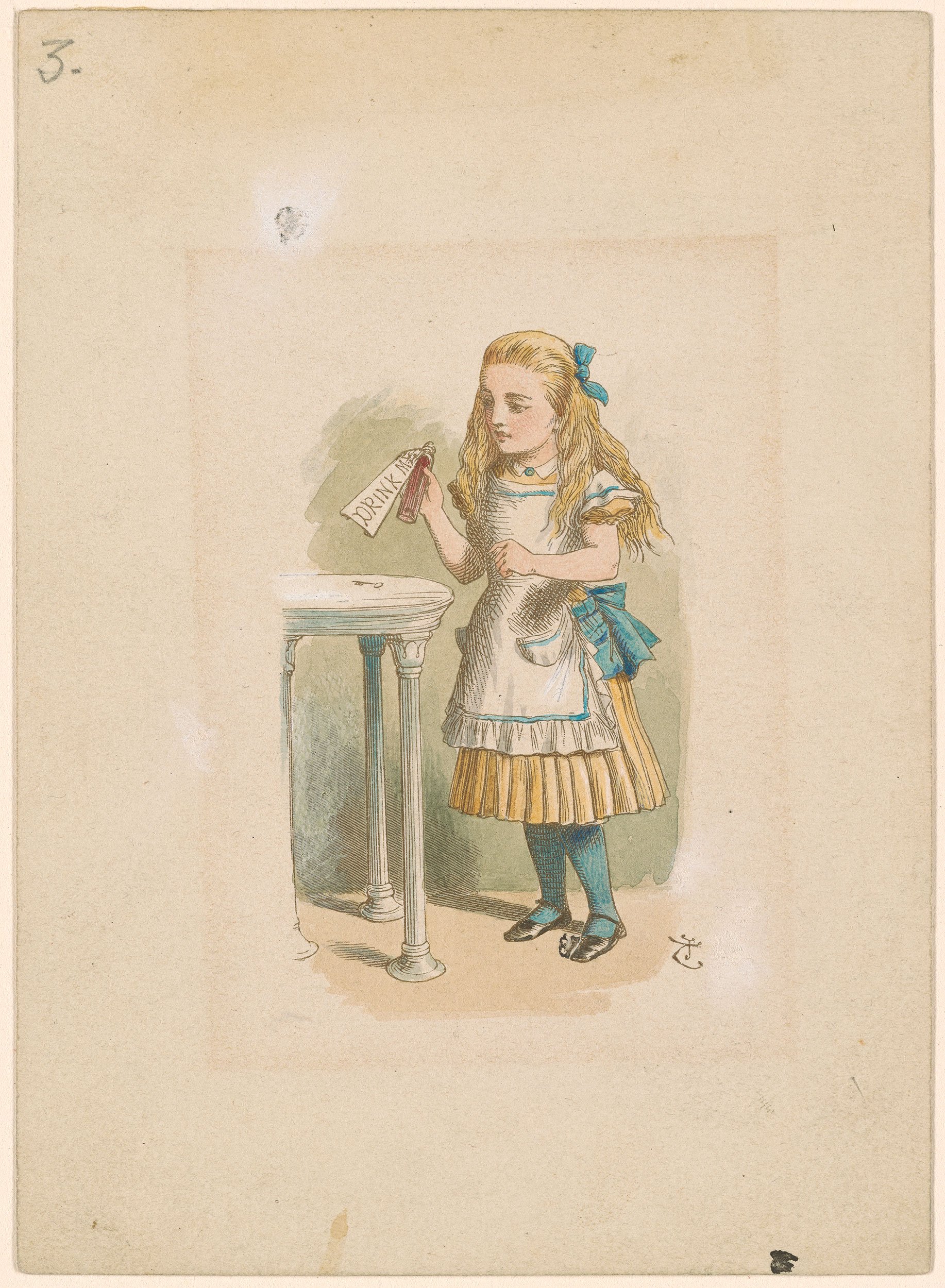
Traditionally, Alice’s Adventures in Wonderland has been thought to reflect themes of growing up, thanks to the recurring motifs of transformation and change propel our hero through an increasingly strange land where nothing seems to make sense. Creatures and landscapes around Alice change constantly, while she undergoes a series of both physical and emotional transformations as she learns important lessons about the process of growing up.
Alice’s physical change after drinking from the bottle labeled “Drink Me” is one of the most prominent examples of transformation in Alice’s Adventures in Wonderland. When she drinks from the bottle, Alice shrinks down to a tiny size and must navigate a world that suddenly seems much larger and more intimidating. This transformation represents the challenges that come with growing up and facing new and unfamiliar situations. Alice must use her wits and resourcefulness to find her way in this strange new world, just as children must learn to adapt and navigate the complexities of the adult world.
The idea of growing up and leaving childhood behind is reflected throughout the book. As she navigates Wonderland, Alice struggles with her own identity and her place in the world. She often feels torn between her desire to remain a child and her longing to be a grown-up. This struggle is epitomized in the scene where Alice encounters the Caterpillar and is asked to identify herself. She responds, “I know who I was when I got up this morning, but I think I must have been changed several times since then.” This quote captures the confusion and uncertainty that often come with the process of growing up and discovering one’s own identity.
In the 20th century, readers found themes that reflected life in a rapidly changing world. The theme of drugs is prevalent throughout the story, and many scholars have interpreted Alice’s experiences as narcotic-induced hallucinations. The story’s surreal and illogical elements can be seen as a reflection of the disorienting effects of drugs, and Alice’s repeated changes in size may represent the feeling of losing control that can come with drug use.
While these associations may seem obvious to a modern audience, there’s no evidence that Lewis Carroll ever experimented with laudanum or other drugs popular in the Victorian era. However, being able to link this Victorian novel to modern life makes Alice relevant to generations of modern readers.
The Alice stories can also be interpreted as meditations on mental health. Alice’s struggles with her own identity and her constantly changing surroundings can be interpreted as a metaphor for the confusion and disorientation mental health issues may bring.
Characters like the Mad Hatter and the Cheshire Cat may be seen as representations of mental disorders such as bipolar disorder and schizophrenia. You might also interpret the Red Queen as having narcissistic personality disorder, although such diagnoses weren’t known in Carroll’s time. Some modern scholars believe Alice’s adventures through Wonderland actually reflected the author’s own experience with autism.
While Carroll insisted that the Alice stories “do not teach anything at all,” you don’t have to look hard to see the theme of spirituality present throughout the book. The story can be read as a metaphorical journey of spiritual awakening, with Alice’s experiences representing a quest for deeper understanding and enlightenment. The dream-like imagery encountered throughout the book can also be seen as a way to explore mystical and spiritual concepts that may not reveal themselves to logic or reason.
Along with being an educator and celebrated author, Lewis Carroll was also Deacon in the Church of England. He personally had deep faith in Christianity and the church, which has led many to look for religious imagery in the Alice stories. While the books can be interpreted as religious allegory, there’s no evidence to suggest Carroll intended the stories to teach religious lessons.
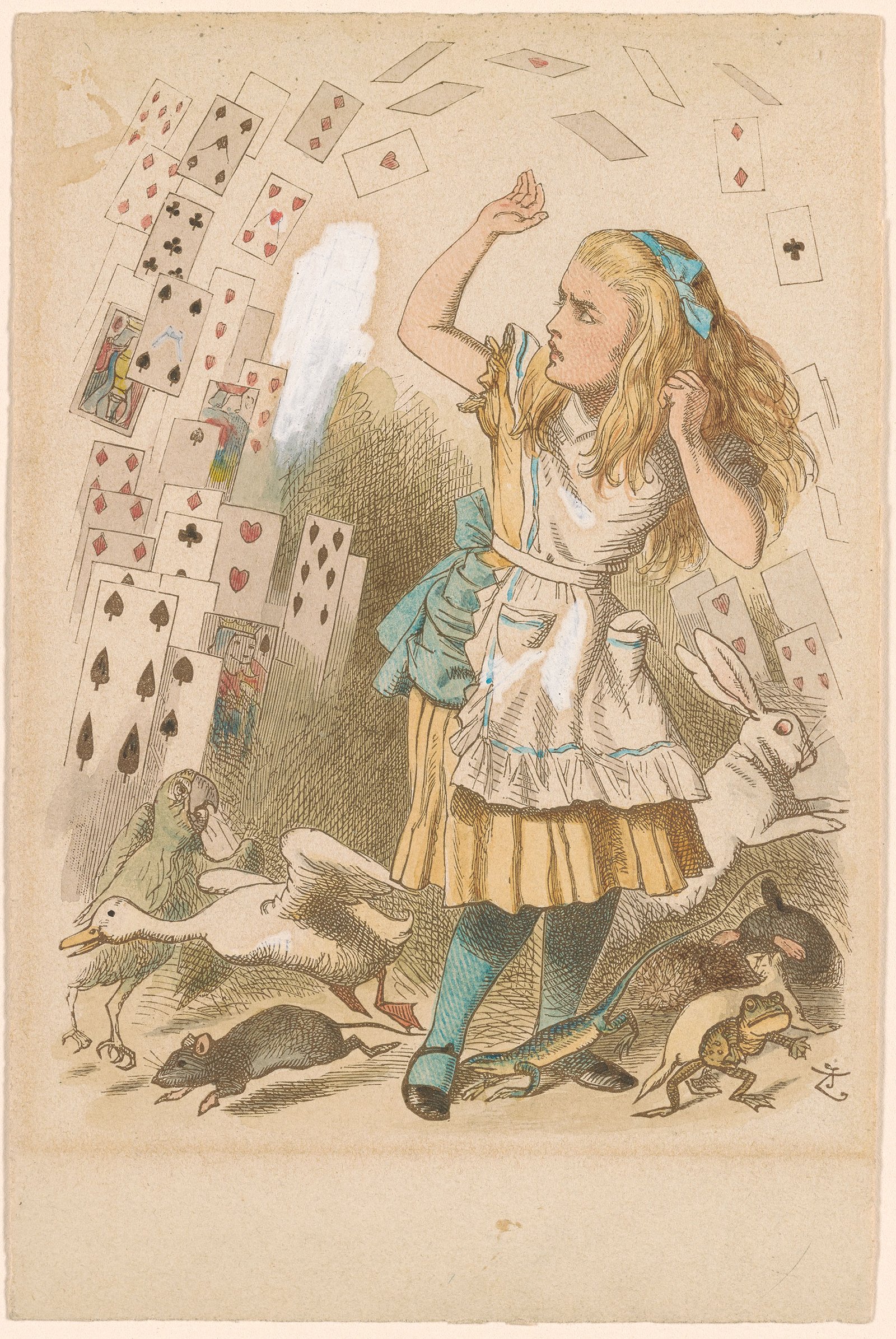
Alice is, of course, the central character of the story, who represents a curious and adventurous spirit. She is a young girl who is always eager to explore new things and challenge the status quo. Alice’s open-mindedness and willingness to try new things make her the perfect guide through the whimsical world of Wonderland.
Alice’s journey through Wonderland is not just physical, but also metaphorical. Her encounters with strange and unusual characters reflect her own personal growth and development. As she navigates this bizarre world, Alice learns important lessons about herself and the world around her. She gains confidence and learns to stand up for herself, refusing to be intimidated by the strange and unusual creatures she meets.
As a figure, Alice also represents the importance of imagination and creativity in our daily lives. Her experiences in Wonderland challenge her understanding of reality and encourage her to question what she thought she knew. This emphasis on imagination and creativity is a central theme of the book, as Alice learns that the world is full of wonder and mystery that can be discovered through a childlike sense of curiosity.
At the same time, Alice can also be considered a commentary on the strict societal norms and conventions of Victorian England. Her encounters with characters like the Queen of Hearts and the Mad Hatter highlight the absurdity of strict social hierarchies and the importance of individuality and self-expression. As the only person willing to stand up to the Queen or question the Hatter’s nonsense, Alice often shatters norms and exposes the oddities inherent in Victorian England culture.
Generations of readers have interpreted Alice as a symbol of the adventurous and curious spirit that exists within all of us. Her journey through Wonderland encourages us to embrace our own sense of curiosity and imagination, and to challenge the norms and conventions of our own society.
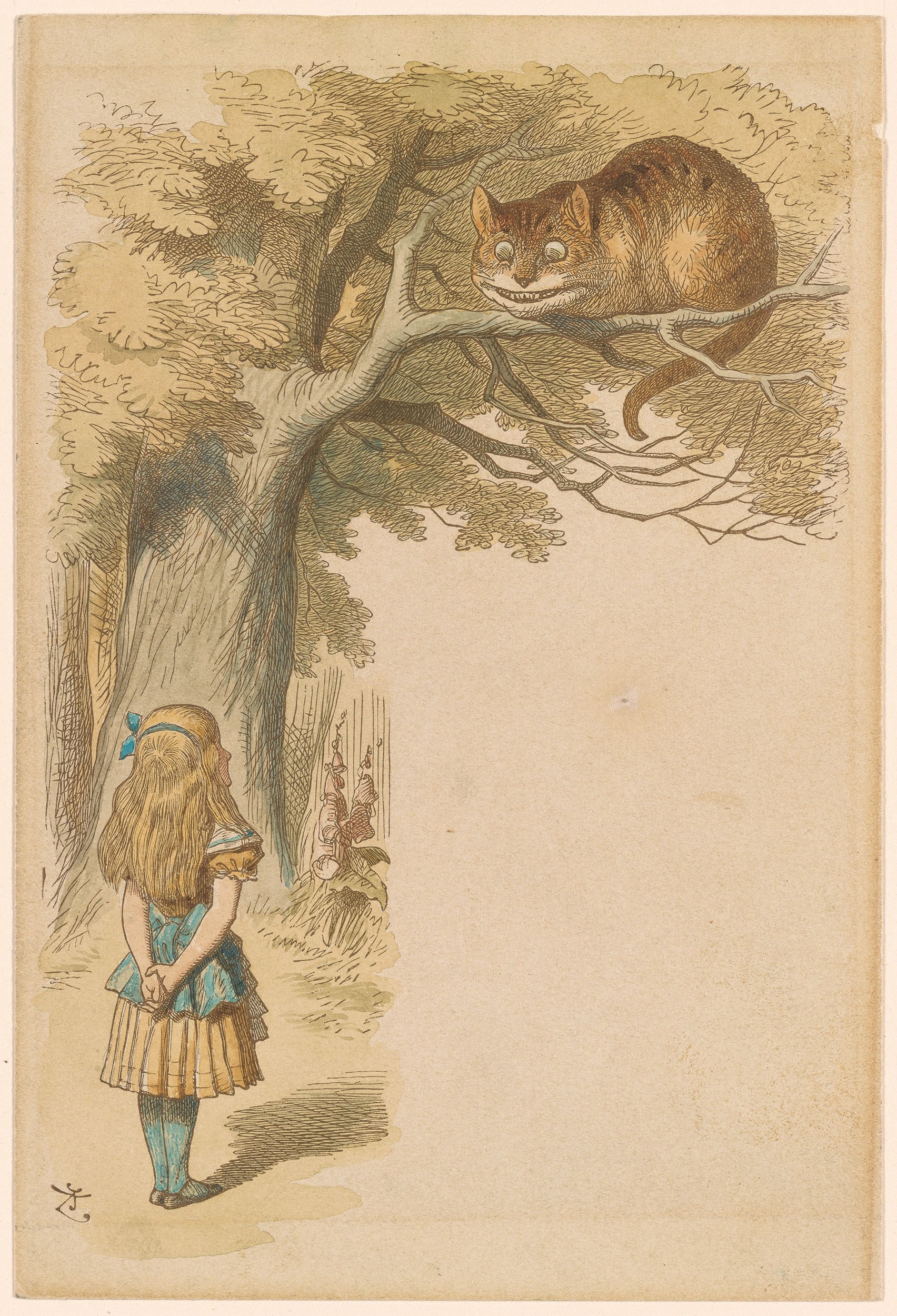
The Cheshire Cat is one of the most iconic characters in the story. This cat, who can disappear and reappear at will, is one of the most sensible creatures in Wonderland, although his wisdom is hidden in jokes and riddles. Acting as Alice’s guide, he offers sage advice and some of the book’s most memorable lines, such as the famous “We’re all mad here, you see.”
The fact that he can disappear and leave only his grin behind represents the elusive nature of truth and the unknowable mysteries of the universe. Additionally, his cryptic and sometimes nonsensical comments can be interpreted as a symbol of confusion and madness.
One interpretation is that the Cheshire Cat represents the concept of ambiguity. Throughout the book, Alice finds herself in situations where things are not quite what they seem. The Cheshire Cat, with its disappearing and reappearing act, embodies this idea of uncertainty and fluidity. This also reflects a kind of moral ambiguity. The cat doesn’t always behave in ways that are easily classified as good or bad, which can be confusing for Alice and other characters in the story. The Cheshire Cat also seems to enjoy playing games and teasing Alice, which may represent the capriciousness of life.
Finally, some readers see the Cheshire Cat as a symbol of the power of imagination. The cat is often associated with the idea of dreams and illusions, which aligns with Alice’s journey through Wonderland. By following the cat’s advice, Alice embraces her imagination and enters this surreal world with more confidence, giving her the ability to fully explore this strange world.
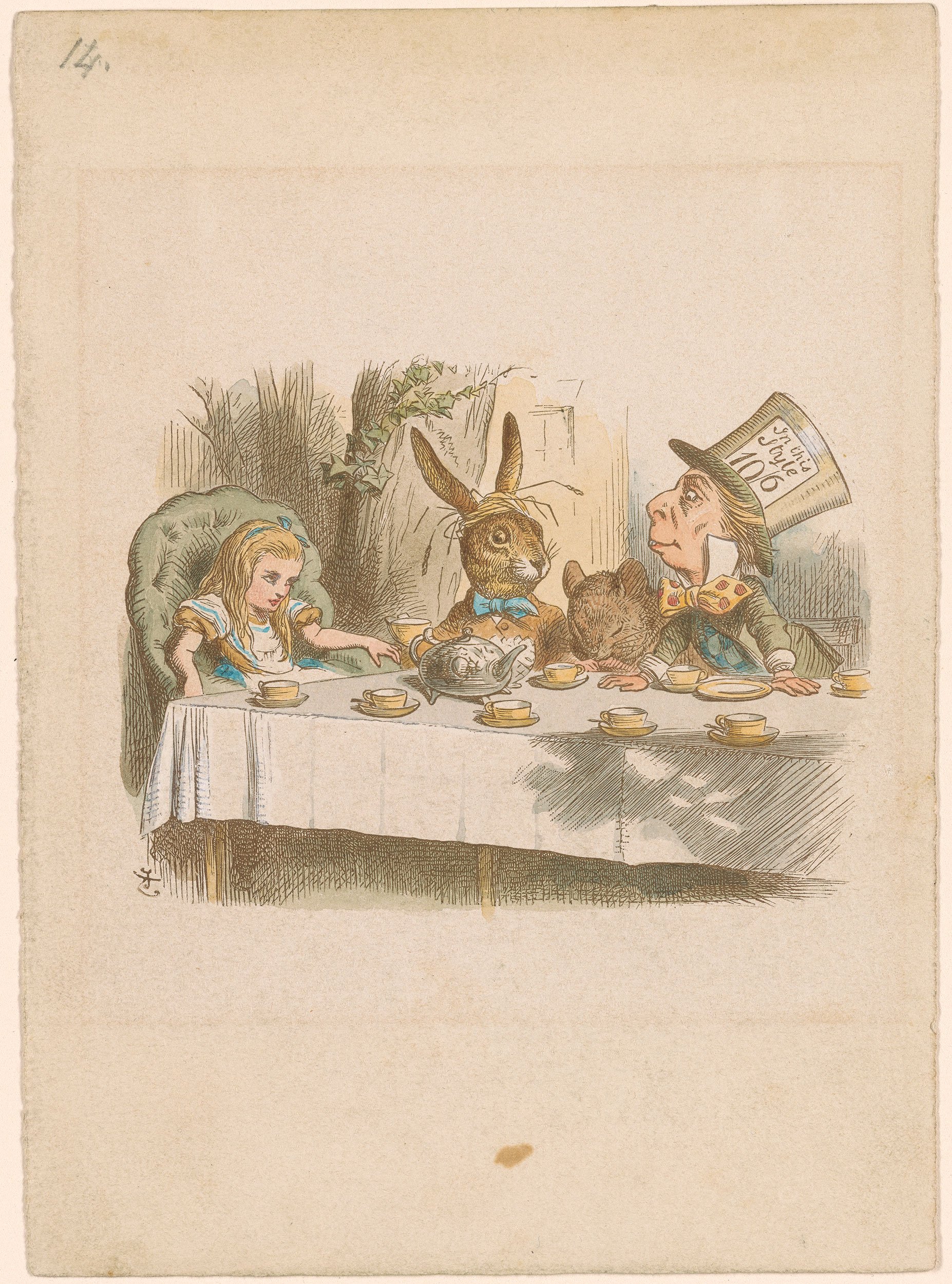
The Mad Hatter is one of the most iconic characters in Lewis Carroll’s Alice’s Adventures in Wonderland, and also one of the most mysterious. The Hatter’s unusual combination of nonsense in the context of a tea party in the forest has led to many different interpretations of this intriguing character.
One common interpretation is that the Mad Hatter represents the chaos and confusion of Wonderland. His nonsensical comments, riddles with no answers, and strange behavior reflects the topsy-turvy world that Alice finds herself in. He’s also obsessed with time, which could symbolize the fleeting nature of Wonderland itself.
Another interpretation is that the Mad Hatter represents the madness of the Victorian era. During this time, people were fascinated with madness and mental illness, and the Mad Hatter could be seen as a reflection of this cultural obsession. His clothing and the fact that he is hosting a tea party could also make him a symbol of the decline of the British aristocracy, which was losing its grip on power and influence during the Victorian era.
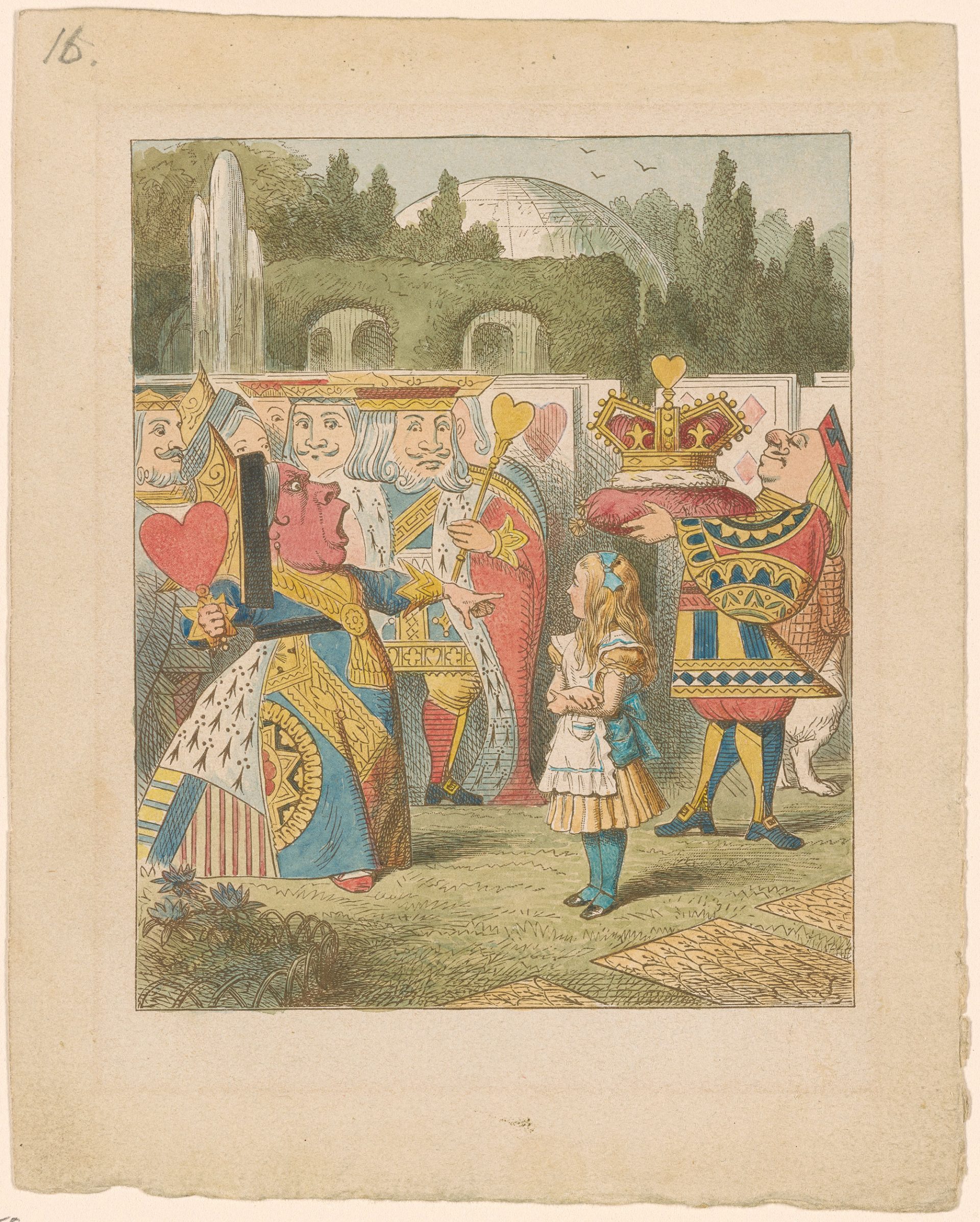
After the Mad Hatter and the Cheshire Cat, The Queen of Hearts might be one of the most well-known characters in Alice’s Adventures in Wonderland. However, unlike the others, the Queen might be one of the most obviously symbolic. She’s a powerful and intimidating figure who represents authority and control, but she’s also irrational and prone to outbursts of anger, which makes her a fascinating representation of the world outside Wonderland.
One common interpretation of the Queen of Hearts is a symbol of the oppressive nature of authority. She’s constantly issuing orders and demanding obedience from her subjects, barking out instructions even as she’s playing croquet with the guests. The Queen of Hearts is also willing to use violence to enforce her will. This reflects how many people perceive those in power, and the dangers of allowing a single individual or group to hold too much sway over society.
To many people, the Queen of Hearts might also represent the arbitrary nature of justice. She’s famous for her catchphrase “off with their heads!”, which she uses to punish anyone who crosses her. The Queen of Hearts doesn’t need a reason, and there are no rules other than her whims. This reflects the idea that justice is often arbitrary and unfair, and that those in power are able to use social structures to suit their own interests.
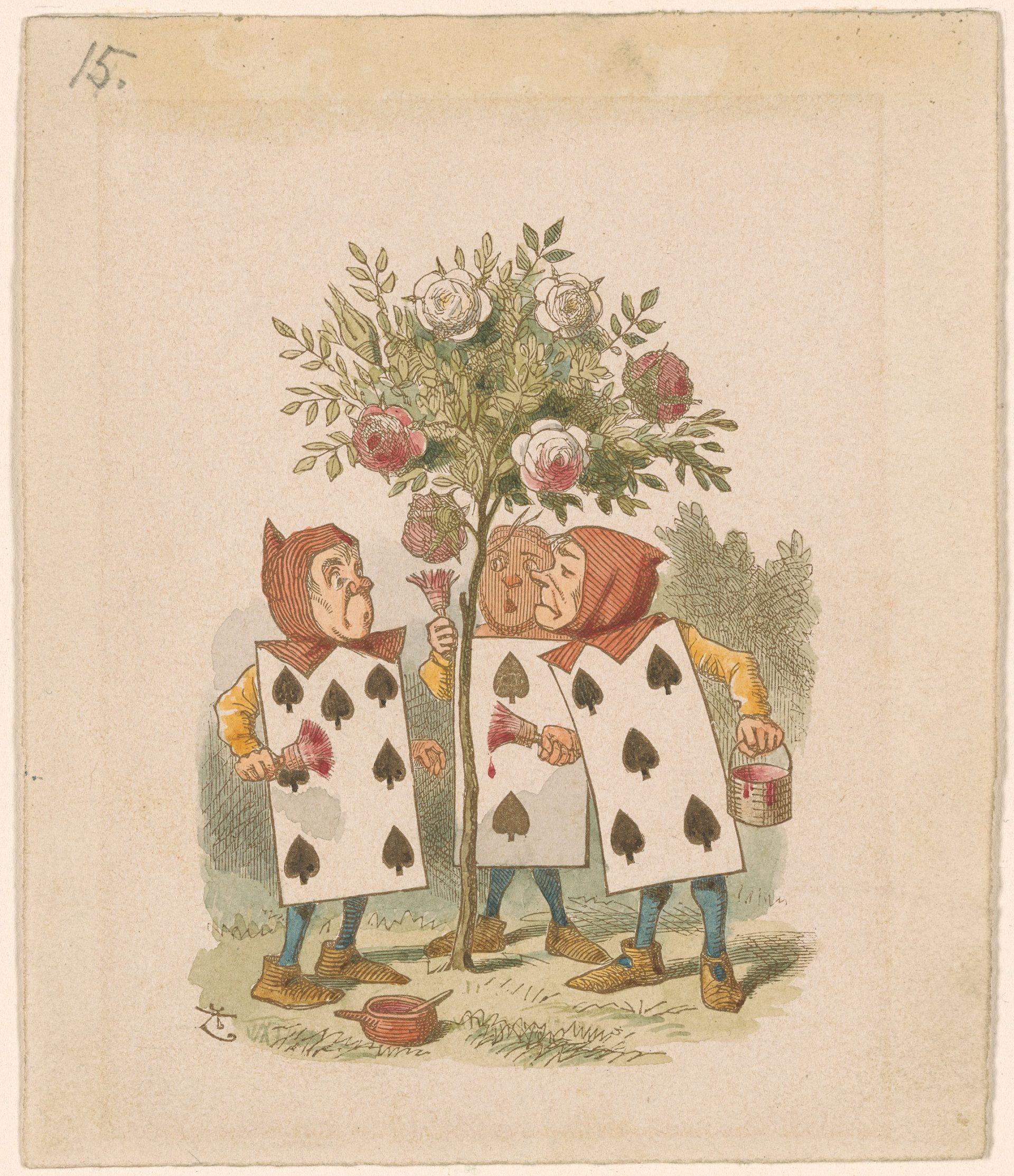
While the talking animals and fantastical creatures of Wonderland are certainly the most memorable characters, the flowers also play a significant symbolic role. In fact, the first creatures Alice encounters on her adventure are talking flowers, who explain that all flowers can talk, but most beds are too soft, so the flowers are usually asleep.
The flowers are anthropomorphized and given personalities, representing the way we often project our own thoughts and emotions onto the natural world. The Rose is particularly judgmental of Alice’s “flowers” and “petals,” and all of them laugh at this strange new “flower” in their midst.
Not only is this a humorous twist on the expected outcome, it’s also a commentary on the tendency of people to judge others by their appearance. The flowers seem sweet and innocent at first, but soon reveal themselves to be petty and cruel, reflecting the idea that even things that seem harmless and pure on the surface can harbor darker motives and intentions.
Another possible interpretation is that flowers represent the fleeting nature of beauty and life. In Wonderland, the flowers are constantly changing color and shape, which reflects the transitory nature of all things in life. This also reflects the idea that beauty is often superficial and temporary, and that it’s important to look beyond appearances to find deeper meaning and value.
Tweedle Dee and Tweedle Dum, a pair of curious and mischievous identical twins, appear to be mirror images of one another. They have a symbiotic relationship where they seem to complement one another perfectly. They share similar characteristics, recite the same poems and songs, and often finish one another’s sentences.
One of the most interesting aspects of Tweedle Dee and Tweedle Dum’s duality is their habit of telling a story before immediately presenting the other side. For instance, after they recite the poem “The Walrus and the Carpenter,” Alice says she prefers the Walrus because he sympathized with the poor oysters. However, Tweedle Dee reminds Alice that he ate more oysters. When she changes her mind, Tweedledum remarks on how the Carpenter ate as many oysters as he could.
Like most characters in Wonderland, Tweedle Dee and Tweedle Dum seem to speak in nonsense and riddles. However, their unique dynamic and approach to truth may represent the limitations of understanding and how far logic can take you.
Food appears over and over again in Wonderland, often playing a significant role in the plot. Throughout the story, Alice is constantly being offered food and drinks that have strange and unexpected effects on her body and mind. Some of these effects are positive, while others are decidedly negative.
Many people view food in Alice’s Adventures in Wonderland as a metaphor for temptation. Alice is frequently tempted by the various foods and drinks that are offered to her, and the consequences of indulging in these temptations are often unpredictable. Mushroom pieces cause her to grow to an enormous size, while a few sips from a bottle make her as small as a mouse. This can be seen as a reflection of the challenges that we face when tempted in the world outside Wonderland.
You could also view food in the story as a representation of the shifting and unstable nature of reality in Wonderland. The foods that Alice consumes often have bizarre and unpredictable effects, which reinforces the themes of the story and the strange world in which she’s found herself. From this perspective, food could be seen as a reflection on the effect our surroundings have on us, and why we should be careful what thoughts and viewpoints we expose ourselves to.
From the talking animals and tea parties to the strange foods and drinks, every element of Alice’s Adventures in Wonderland is filled with symbolism that can be interpreted in a number of ways.
At its core, Alice’s Adventures in Wonderland is the story of a young girl on a journey of self-discovery as she navigates the strange and unpredictable world of Wonderland. Through the lens of this strange, unknowable world, Alice leaves childhood behind and enters adulthood, which can seem frightening, confusing, or even nonsensical.
Whether it’s the Mad Hatter’s tea, the Queen of Hearts’ croquet game, or the mysterious Cheshire Cat, every character and element in the story reflects some aspect of the world as seen through the eyes of a growing child. These elements give the book a deeper meaning that invites readers to engage with the narrative on a more profound level.
While Alice’s Adventures in Wonderland is a silly, entertaining read, it also carries symbolism that has made it a beloved classic that continues to capture the imaginations of readers of all ages. Its enduring popularity is a testament to the power of symbolism and the ability of great stories to inspire as well as entertain, even if the world they depict seems mad.
